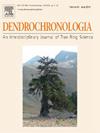Pan-alpine summer temperatures since 742 CE
IF 2.3
3区 农林科学
Q1 FORESTRY
引用次数: 0
Abstract
Albeit labor-intensive, tree-ring maximum latewood density (MXD) has become a prime proxy to reconstruct inter-annual to multi-centennial climate variability. We here combine such data from five valleys in Austria, France and Switzerland to present a June-September temperature history for the European Alps reaching back to 742 CE. The pan-alpine record correlates at r1880–2023 = 0.89 with observational data and provides evidence for a prolonged Little Ice Age (LIA) from the 1250s to 1850s CE, during which summer temperatures were 0.59 °C cooler compared to the preceding Medieval Warm Period (MWP) from the 880s to 1240s CE. Temperatures rose by 3.65 °C from the coldest decade in the 1810s, which includes the 1816 CE post-Tambora “year without a summer”, to the warmest decade in the 2010s. The warmest summer in our reconstruction occurred in 2003 CE (+ 2.71 °C) and exceeds the warmest naturally forced summer in 970 CE (+ 2.19 °C) by more than 0.5 °C. This difference is non-significant, however, if we consider the increasing uncertainties back in time when fewer sites and trees contributed to the reconstruction. The pan-alpine record is the result of conducting MXD measurements over the past two decades in Swiss and German laboratories and sets a new standard in terms of explained variance and pre-instrumental temperature variability estimation in the European Alps.
公元742年以来的泛阿尔卑斯夏季气温
树木年轮最大迟木密度(MXD)虽然是劳动密集型的,但已成为重建年际至百年气候变率的主要指标。在这里,我们将奥地利、法国和瑞士五个山谷的数据结合起来,呈现出欧洲阿尔卑斯山6月至9月的温度历史,可追溯到公元742年。泛高山记录在r1880-2023 = 0.89与观测资料相关,并提供了1250年代至1850年代的小冰期(LIA)延长的证据,在此期间,夏季气温比之前的中世纪暖期(MWP)低0.59 °C(880 - 1240年代)。从19世纪10年代最冷的十年(包括1816年的“无夏之年”)到2010年代最暖的十年,气温上升了3.65 °C。在我们的重建中,最热的夏季出现在2003年(+ 2.71 °C),比970年(+ 2.19 °C)最热的夏季高出0.5 °C以上。然而,如果我们考虑到重建过程中越来越少的场地和树木所带来的不确定性,这种差异就不显著了。泛阿尔卑斯记录是瑞士和德国实验室在过去二十年中进行MXD测量的结果,并在欧洲阿尔卑斯地区的解释方差和仪器前温度变率估计方面设定了新的标准。
本文章由计算机程序翻译,如有差异,请以英文原文为准。
求助全文
约1分钟内获得全文
求助全文
来源期刊

Dendrochronologia
FORESTRY-GEOGRAPHY, PHYSICAL
CiteScore
5.50
自引率
13.30%
发文量
82
审稿时长
22.8 weeks
期刊介绍:
Dendrochronologia is a peer-reviewed international scholarly journal that presents high-quality research related to growth rings of woody plants, i.e., trees and shrubs, and the application of tree-ring studies.
The areas covered by the journal include, but are not limited to:
Archaeology
Botany
Climatology
Ecology
Forestry
Geology
Hydrology
Original research articles, reviews, communications, technical notes and personal notes are considered for publication.
 求助内容:
求助内容: 应助结果提醒方式:
应助结果提醒方式:


